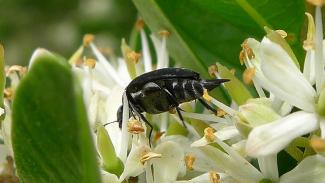
Image Credit: John Tann
Flower-beetles (Trichocrous) and tumbling-flower beetles (Melyridae, Mordellidae) – herbivores on green fleshy plant parts. In nearly every setting, small melyrids are present in great richness and enormous density. Trichocrous is the most omnipresent and abundant in the PNW, and it can be found visiting every possible flower species. The tumbling flower-beetles (and the similar Anaspis (Melandryidae) are also omnipresent and abundant, but they are usually restricted to the carrot family and other clustered inflorescences made of tiny flowers (i.e., ocean-spray (Holodiscus)); this helps facilitate their escape reflex of tumbling to the ground when startled. Both of these groups of beetles are, on the whole, tiny and difficult to separate at the species level.




Tumbling-flower beetles are easy to identify (2 on the left) if they have a protruding tail (but, not all genera have the tail); the immatures live in plant pith. The third picture is Trichocrous; biology is not known. Anaspis almost always co-occurs with tumbling flower-beetles, but apparently is completely unrelated. The orange/reddish species is the commonest and most widely distributed.